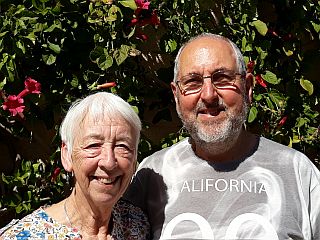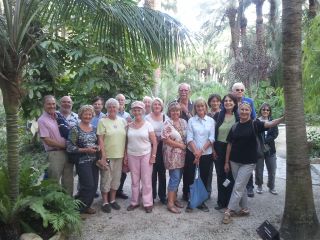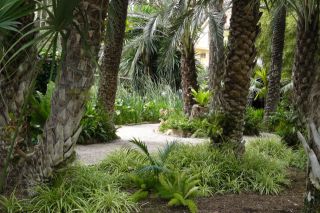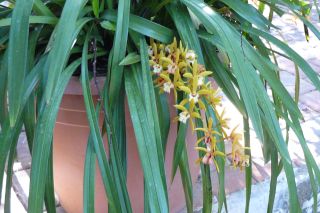» Home
» About
» Membership
» Journal
» Sparoza Garden
» Branches
» MGS Forum
» Seed Exchange
» Donations
» MGS Excursions
» Information
» Members' Gardens
» Book Reviews
» News & Views
» Contact
» Search
BRANCH HEAD
Alan Hawes

Versión española
|
The Costa Blanca Branch of the MGS
Past Events 2017 2016 2015 2014 2013 2012
November 2011
Branch meeting in Pat and Ken Robinson's garden, Jávea
With extremely unstable weather at the beginning of November, it was reluctantly decided to hold the branch meeting close to the majority of members' homes. Pat and Ken Robinson were kind enough to offer their garden for the venue. The members who had attended the AGM in Mallorca briefly gave their impressions of the gardens visited on the island. This made everybody aware that the perception of a garden is highly personal. What was experienced as a wonderful garden full of harmony and tranquillity by one member seemed to another hopelessly old-fashioned. What some saw as an excellent example of beauty, elegance and clarity lacked intimacy for others.
This year we had quite a few branch meetings to become acquainted with our members' gardens. In 2012 there will be fewer branch meetings, and instead various excursions to gardens, both new ones and familiar ones, a lecture by Jan van Eijle, a specialist in invasive and endemic plants, a visit to a winery in the Valencian hills where the Romans once cultivated vines, and a visit to another botanic garden.
The branch meetings will also provide the opportunity for members to exchange plants and seeds for members. Carol and Alan Hawes will kindly organize a plant/seed list so that members can also contact others also directly to exchange plants and seeds.
Just as gardens are perceived in different ways, so it became clear during the meeting that there are also various gardening philosophies; it might be well worth dwelling on this subject during one of our future branch meetings.
Unfortunately, we had a practical lesson in red palm weevil treatment in the afternoon, as Pat and Ken's gardener thought it appropriate to come back and inspect one of their magnificent Phoenix canariensis more closely. And indeed, they found beetles and larvae and the whole tree had to be cleaned and fronds cut off. It was then treated with insecticide, fungicide, fertilizer, and a fourth product to activate the flow of the sap, all injected into the trunk. Interestingly, the tree became infected although it had been treated preventively every six months for the past two years.
After this dry summer the red palm weevil has now fully struck the coastal towns of Dénia, Jávea, Teulada-Moraira, and many others along the Costa Blanca coast. So far, twenty-seven different species of palm trees have been infected. One member pointed out that there is a new biological treatment, not a fungus but a nematode, which very effectively destroys the larvae, pupae and beetles after an initial chemical treatment. The product is called Palmanem (Koppert, Biological Systems).
All in all it was a fruitful meeting with interesting discussions combined with delicious food provided by our members.

The side fronds of the Phoenix canariensis were cut off
to give access to the top so that the crown could be cut out

Cupressus sempervirens (trimmed), Aloe arborescens, Strelitzia gigantea
(syn. S. reginae subsp. reginae), in the background Pinus halepensis
Photos by Pat Robinson
October 2011
The Costa Blanca excursion
A small group of ten members from Australia, California, France, Germany and England did a kangaroo hop (the Australian BH seems to be anticipating a major MGS event in 2012) from Mallorca to Alicante by plane and came to stay in Jávea for a long week-end to visit gardens in our region. Perhaps it was this change from the large groups visiting gardens at the AGM to such a small group which made it so special for all of us. The tour included larger gardens (the Albarda Garden near Dénia and Carol and Alan Hawes' garden in Crevillente), and much smaller ones (the palm garden of the Huerto del Cura in Elche, Edith and Bill Haeuser's garden and Pamela and Ron Steele’s garden, both in Jávea).

In the Rose Garden, in the shade of Melia azedarach

In the African Garden, with aloes, gazanias, an arbour
covered with Podranea ricasoliana, and a large African acacia tree

In the palm garden of the Huerto del Cura, Elche

Navel oranges against a backdrop of Trachelospermum jasminoides,
in the background Schefflera actinophylla and Plumbago capensis

Osteospermum fruticosum, Polygala myrtifolia, on the
lower terrace a Persea americana (avocado tree)

Inflorescence of Fatsia japonica amongst river boulders
together with low-growing rosemary and Agave attenuata

Anise-scented Salvia guaranitica under Syagrus romanzoffiana in early autumn
Photos by Alan Hawes, Edith Haeuser and Pamela Steele
Since Jávea and especially the area around the local Montgó mountain is a botanical hotspot, Juan Torres, botanist and co-author of a book entitled Guía Botànica del Parc Natural del Montgó, was invited to give an hour's talk about the local flora and the special geological and meteorological conditions in the nature reserve near the cliffs of Jávea. The local members who joined the visitors on their tour thoroughly enjoyed their company. All appreciated the hospitality of the Costa Blanca members, and it was unanimously agreed that it had been a very rewarding and unforgettable week-end.
September 2011
Visit to the botanic garden in Valencia
The Botanic Garden of the University of Valencia is one of Spain's historic botanic gardens, which began as a garden with medicinal plants for medical students in the second half of the 16th century. In 1802 a new location was chosen with new goals for the botanic garden. It was the time when everywhere in Europe researchers, with great scientific enthusiasm, were categorizing and systematizing flora and fauna. Unfortunately the garden was neglected in the 20th century and deteriorated until restoration began in 1987. The completely restored garden was inaugurated in 2000.
Olga, a young botanist from the Botanic Institute of the University of Valencia, guided us very competently on a two-hour tour through the garden. We had lunch at an excellent vegetarian restaurant nearby. Before returning to Jávea by coach we briefly visited the Jardín de los Hesperides, adjacent to the Botanic Garden. This is a small modern garden, with a clear, linear design - a total contrast to the garden which we had just visited. Tall green walls of cypresses, about twenty species of potted citrus trees - a symbol of the most important trees in Valencian agriculture - rectangular fields of Rosmarinus prostratus, and statues representing figures from Greek mythology form a green oasis just a few steps away from a very busy street.

Brachychiton acerifolius x Brachychiton populneus

Tipuana tipu
Photos by Pamela Steele
July 2011
Branch Meeting in Jávea
Our branch meeting took place in Pamela and Ron Steele's garden. It was a splendid summer's day, and we all had a delightful and inspiring time in their beautiful garden close to the sea.

Dicliptera suberecta, Hydrangea macrophylla ‘Normalis’, Gaura lindheimeri.

Echium candicans, Agave americana var. marginata
Alan and Carol Hawes reported some bad news: Three of their agaves have been killed by the agave weevil/agave snout-nosed beetle (Scyphophorus acupunctatus). They are looking into treatment and will report about their findings at a later date.
Carmen Pena, Professor Emerita for the Theory and History of Art, who visited some of our
Costa Blanca gardens with the Amigos del Real Jardín Botánico de Madrid in May, has written a very interesting article on Christine Lomer's iris garden, entitled Lirios y bancales. The Mediterranean Garden Society en las Marinas (dated 14 May 2011). Please take the time to read it on her blog.
May 2011
The Garden of Alan and Carol Hawes
The first official branch meeting took place in the garden of Alan and Carol Hawes in the agricultural zone of Crevillente, south-west of Alicante. We were all looking forward to seeing their garden, which they had described as follows:
Our garden is fairly new, as we started developing it only eight years ago. We bought our plot in 2004, in a fruit-growing and horticultural area south of Crevillente. It was an orchard of 10,000 square metres planted mainly with orange trees (250 approx.), but also having some lemons and figs. Because this is a very dry area with precipitation of less than 300 mm a year, agriculture depends on a well-developed system of water supply through a network of canals. With this agricultural water supply and good soil that is fertile but low in humus, we had the basis for a garden.
We started planting in 2005, having fenced an area of 3,500 square metres at one end of the plot, which was to form the garden around the house. At the other end of the long plot, a plantation of 500 trees was started, mainly using about twenty species of eucalyptus. The garden has themed areas for plants from mediterranean and temperate climate areas of Australia, from Africa and the Americas. Australia is a fairly informal area with mostly trees and shrubs, all from the south of that continent. It is especially colourful in winter and spring, when the eucalyptuses, cassias and callistemons are in bloom. Africa has both a dry area, featuring a wide range of aloes, aeoniums, mesembryanthemums, etc. and a more shrubby area, featuring an arbour covered by Podranea. The Americas have a desert area with a wide range of agaves, yucca and cactus species, a section of 'prairie planting' with grasses and drought-tolerant herbaceous plants and bulbs, including a shady corner under tipuanas and jacarandas, planted with flowering shrubs. There are Washingtonia palms along one side, while Syagrus, Brahea and Butia palms enhance the other beds. We have an avenue of orange trees and a well-watered area for moisture-loving plants, designed around some of the original orange trees.

Photo by Alan Hawes
In recent years we have developed two formal areas behind the house, allocated in the original plan, a Rose Garden and a Pergola Garden. The Rose Garden has a geometric layout, with circles and crossing paths creating beds full of herbaceous plants and shrub roses, with shade from Melia trees and rustic arbours. The Pergola provides a shady sitting area behind the house, covered with many climbing plants - bougainvilleas, roses, etc. at their peak in the summer - and a small area of very colourful herbaceous planting in a cottage garden style.

Photo by Alan Hawes
We have done all the work of planning and establishing the garden ourselves, as we wanted it to be entirely our creation. Much of it has been an experiment, and although drought and light frosts have taught valuable lessons and changed our plans, we have also made some unexpected discoveries about what will succeed here. It is not finished - we hope it never is - but evolves within our plan, as ideas are found to be more or less successful.
It was a new and exciting experience at this branch meeting to see a garden with plants and trees arranged according to their continent of origin. We were impressed by the many trees which Alan and Carol had started from seed, e.g. the eucalyptuses, some of which were still blooming, David Austin roses, such as 'Jude the Obscure', and the pale blossoms of Melia azederach trees, which wrapped us in their enchanting fragrance in the Rose Garden. Arbours, which Alan had made of bamboo, allowed the visitors to escape from the sun and enjoy the perfumed air.
A message from the President to the new branch
Jocelyn van Riemsdijk, the former head of the Languedoc Branch, was our special guest, and she attended our meeting as Jean Vaché's personal envoy. He would like to encourage all members of our branch to express their opinion on his first two President’s Letters in the MGS Journal (January and April 2011). Please do not hesitate to email him.
He told us of plans to set up a Spanish mini-website, like the French and Greek ones that already exist, to attract more Spanish members, and suggested that we send out two versions of our monthly newsletter, in Spanish and in English – this will also be an incentive for us to improve our knowledge of Spanish. He also invited all our members to contribute texts, short or long, to the MGS Journal.
The Branch Head reports on the red palm weevil (picudo rojo)
Susi Gomez, a researcher at the Palm Research Centre in Elche (Estación Phoenix-Ayto de Elche), had given a lecture on the red palm weevil (Rhynchophorus ferrugineus) at the Casa de Cultura in Jávea a few weeks before our meeting. At that centre in Elche researchers are determined to eradicate this terrible pest, since keeping it at bay has failed. They want to persuade the government to pass a law which would force every private owner of palm trees to use chemical treatment, both as a preventive measure and as a cure. The palm trees must be treated every three to four months with alternating substances. Equally important are frequent visual checks for larvae and beetles at the base of the fronds, since they feed on the sap. In other words, it would be counter-productive to fell a tree since the red palm weevil is not xylophagous (eating wood); only the fronds must be cut completely and burnt in situ. As with Cycas spp, palm fronds will start to grow again after a few weeks, and should then be treated preventively. The treatment, spraying at the top or injections at the base of the trunk (which is cheaper), must be carried out by professionals. The hole produced by an injection will heal promptly, as palm trees have an incredible facility to recover. The injection will need one month to reach the fronds. It is also possible to place traps with pheromones, but there is a certain danger of attracting more beetles, and it should therefore be used exclusively in combination with other methods. Contrary to general opinion, trimming palm trees does not increase the number of infected trees. In fact, it is by trimming the fronds that eggs, larvae and beetles can be detected. Once a palm tree is infected, the fronds must be removed; it would be wrong to wait until the whole tree has died. In short, the key to success is early detection and prompt treatment of infected trees.
As a medical doctor confirmed to me, all these substances available for treatment (e.g. thiamethoxam for injections, and imidacloprid for spraying, among others) contain concentrated nicotine and are therefore not only very effective but also carcinogenic. I would certainly discourage those who frequently have children in their garden from treating their palm trees chemically. The results of an investigation by the Colegio Oficial de Biólogos de Galicia of insecticides which contain nicotine was quoted in an article in a recent issue of the Spanish magazine integral (no. 376, p. 10). Those insecticides have been prohibited in France and Germany for more than two decades, but are very popular in Spain. They suspect that insecticides containing nicotine are partly responsible for the disappearance of bees.
The red palm weevil appeared in India for the first time in the 1950s, then gradually spread through the Orient to the Eastern Mediterranean countries and was finally detected in the south of Spain in 2006. From Andalucía it moved northward along the coast and has now reached the northern part of the Costa Blanca. This pest, which originally fed on coconut palm trees, has acquired a voracious appetite for Phoenix dactylifera, P. canariensis and Washingtonia. For further information, please contact Susi Gomez.
An AGM in Australia
We came unanimously to the conclusion that it would no doubt be interesting but too far away. Great enthusiasm was expressed for an AGM in Portugal, especially in the region of Sintra, or in Italy.
At the end of the meeting someone suggested an excursion to the Botanic Garden in Valencia. The date will be fixed at the next branch meeting (scheduled for Saturday 2 July). We spent a wonderful and inspiring day in the garden of Alan and Carol Hawes, and I am sure that some of us, motivated by their success, will also feel tempted to use seeds more often.
Edith Haeuser.
May 2011
A Two-Day Visit by Members of the Amigos del Real Jardín Botánico de Madrid (Friends of the Royal Botanic Garden in Madrid)
The visit was guided by Dr. Inmaculada Porras, the Vice-President of the Real Jardín Botánico Juan Carlos I, University of Alcalá de Henares. The group of twenty-nine stayed in Jávea and visited the gardens of several of our members.
Christine Lomer's Iris Garden
We first visited the iris garden of Christine Lomer at Los Pinos, Benissa. Two years ago the Royal Botanic Garden of Madrid purchased 500 irises from Christine, and so the visitors were very keen to see Christine's irises in their original setting. It is a truly fascinating garden at an altitude of 350 metres above sea-level with the majestic Bernia mountain in the background. Most of the irises were blooming, a feast of colour. They thrive in mediterranean climate conditions without any irrigation in summer. Christine built her garden with great sensitivity on the original broad agricultural terraces with dry stone walls, which are so typical of our area. She left the old olive trees, planted flowers and low shrubs in their dappled shade and discovered that many plants thrive extremely well in the vicinity of these trees. Every year she expands the garden, one year focusing on salvias, then experimenting with roses appropriate to the mediterranean climate (climbers, ramblers, shrubs), then African bulbs, and trees.


The Huerto del Cura
The next stop was at the Huerto del Cura (the Curate's Orchard) in Elche, more than a hundred kilometres south of Jávea. This was originally the private palm garden of a priest in the early 19th century and is still in private hands. It contains almost a thousand palm trees from various parts of the world, and a collection of cacti adapted to the Mediterranean climate. But it is above all a green and wonderfully shady garden with an atmosphere of tranquillity and harmony. Entering Elche feels almost like entering an oasis, for the town has around 300,000 palm trees (declared a World Heritage site by UNESCO). Many are now in the main public park, but some are still in their original sandy ground. The Phoenicians introduced the palm tree into the region of Elche, but the Arabs in the Middle Ages created this exciting palm forest.


After lunch at a restaurant in the public park in Elche, we visited the garden of Alan and Carol Hawes nearby in Crevillente. (For a description of their garden, see the May Branch Meeting above.)
Francisco's Garden
On Sunday morning we first visited the garden of Francisco, a local citizen of Jávea and a dear friend, who has been a passionate gardener all his life and still experiments with seeds and cuttings. His garden is located at the edge of Jávea at the foot of the Montgó (max. alt. 753m). This location is probably the reason why so many of his potted plants (orchids, among others) were damaged or even destroyed by frost this past winter when the temperature twice dropped below zero in his garden; he had never experienced that in the past 45 years. Time passed quickly with his interesting comments on his plants and trees, some of which are very old species which no one else in Jávea has. As Dr. Porras pointed out, part of the charm of his garden is that it reflects the medieval Moorish style of this region, which always combined flowers, orchards and vegetables: a great pleasure for eye and palate alike throughout the year. Francisco is well-known in the village not only for his garden, but also for his excellent cocas (a kind of mini-pizza and a speciality of the Valencian region), and so he got up before 5 o'clock in the morning to heat his outdoor oven and prepare cocas for all of us. I realized how happy everybody was that they could visit the garden of a local Spaniard. Especially the botanists among the visitors greatly appreciated the large number of unusual species that Francisco has cultivated. It also reminded me how important it is to include more Spaniards in our branch. Francisco does not speak English, but I wonder if we could declare him an honorary member.


The Albarda Garden
The next stop was at the Albarda Garden of Enrique Montoliu, who led the group personally through his beautiful garden. It was established 20 years ago on 50,000 square metres with the intention of creating a garden with mediterranean plants which would not need any summer watering. Close to the house, the garden is more formal with low Myrtus hedges around graceful Seville orange trees (Citrus aurantium), pergolas with climbing roses and Wisteria, and cypresses. There is also a Valencian garden, which reflects the medieval Arab influence in this region. Then there are the much more natural parts, a Mediterranean forest and an artificial hill with many of the plants that grow on our local Montgò mountain – the famous botanical hotspot of our region – with about 60 endemic plants and more than 600 species. As an echo of the Arab garden the element of water is omnipresent: water cascading from the artificial hill, water in ponds, water in fountains. It is a garden which invites the visitor to stroll on paths tiled with intricate patterns (also inspired by Arab gardens) and discover new things at every bend, or follow the narrow natural paths through the forest while listening to the song of nightingales and other birds.
The Albarda Garden has become an important educational tool for our region, and it increasingly attracts local people as well as foreigners. It is open to the public on the last Saturday of every month.


After a copious lunch in Jávea, Dr. Porras took the group back to Valencia for a guided tour through the Botanic Garden, which is more than 200 years old and is famous for its interesting old trees from all over the world.
Edith Haeuser.
February 2011
Creation of the Costa Blanca MGS Branch
A group of Costa Blanca MGS members met on Wednesday 16 February 2011 for the first time at our house to discover how we would want to proceed. It was unanimously agreed that there should be a new Costa Blanca Branch of the MGS. We also decided that during this first year we would focus on
visiting members' gardens - we are still a very small Branch – where we shall exchange our gardening experiences and share our successes and failures. We had such an inspiring first meeting that I completely forgot to take some photographs of the members present. |


